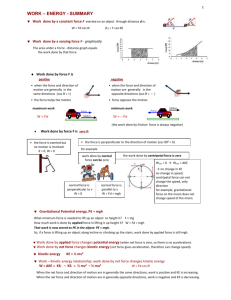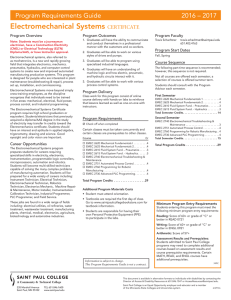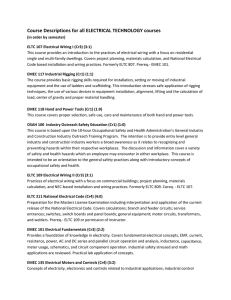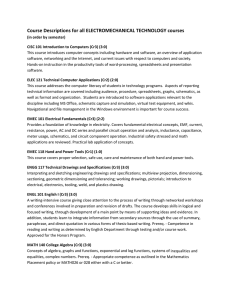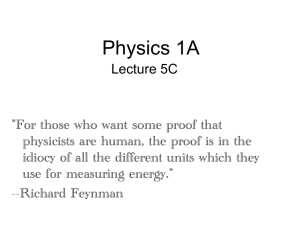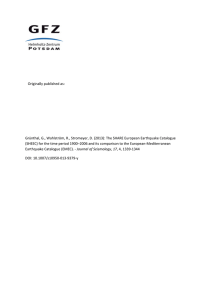Chapters: 7 and 8
advertisement
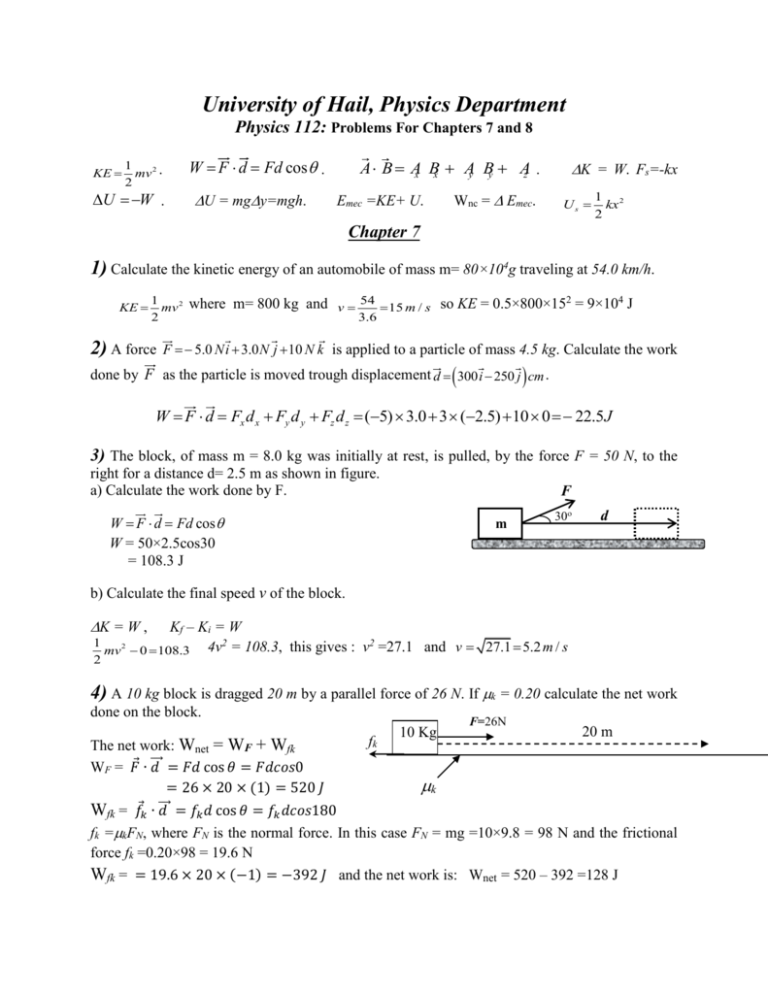
University of Hail, Physics Department Physics 112: Problems For Chapters 7 and 8 KE W F d Fd cos . 1 mv 2 . 2 U W . U = mgy=mgh. A B Ax Bx Ay By Az .Bz Emec =KE+ U. Wnc = Emec. K = W. Fs=-kx Us 1 2 kx 2 Chapter 7 1) Calculate the kinetic energy of an automobile of mass m= 80×104g traveling at 54.0 km/h. KE 1 mv 2 2 2) A force where m= 800 kg and v 54 15 m / s 3.6 so KE = 0.5×800×152 = 9×104 J F 5.0 Ni 3.0 N j 10 N k is applied to a particle of mass 4.5 kg. Calculate the work done by F as the particle is moved trough displacement d 300 i 250 j cm . W F d Fx d x Fy d y Fz d z (5) 3.0 3 (2.5) 10 0 22.5J 3) The block, of mass m = 8.0 kg was initially at rest, is pulled, by the force F = 50 N, to the right for a distance d= 2.5 m as shown in figure. a) Calculate the work done by F. F W F d Fd cos W = 50×2.5cos30 = 108.3 J m d b) Calculate the final speed v of the block. K = W , Kf – Ki = W 4v2 = 108.3, this gives : v2 =27.1 and v 27.1 5.2 m / s 1 mv 2 0 108.3 2 4) A 10 kg block is dragged 20 m by a parallel force of 26 N. If k = 0.20 calculate the net work done on the block. The net work: Wnet = WF + Wfk ⃗⃗⃗⃗ = 𝐹𝑑 cos 𝜃 = 𝐹𝑑𝑐𝑜𝑠0 WF = 𝐹⃗ ∙ 𝑑 = 26 × 20 × (1) = 520 𝐽 Wfk = 𝑓⃗𝑘 ∙ ⃗⃗⃗⃗ 𝑑 = 𝑓𝑘 𝑑 cos 𝜃 = 𝑓𝑘 𝑑𝑐𝑜𝑠180 fk 10 Kg F=26N 20 m k fk =kFN, where FN is the normal force. In this case FN = mg =10×9.8 = 98 N and the frictional force fk =0.20×98 = 19.6 N Wfk = = 19.6 × 20 × (−1) = −392 𝐽 and the net work is: Wnet = 520 – 392 =128 J 5) A 7 kg block is dragged 15 m by a force F=20 N that make an angel of 35o with the 20 N 35o 15 m horizontal. If k = 0.20. 7 kg a) Calculate the work done by the force F. k WF = 𝐹⃗ ∙ ⃗⃗⃗⃗ 𝑑 = 𝐹𝑑 cos 𝜃 = 𝐹𝑑𝑐𝑜𝑠35 = 20 × 15 × 0.82 = 246 𝐽. b) Calculate the work done by the frictional force. fk =kFN where FN is the normal force. We will calculate the normal force first. y From the free body diagram “FBD” on the y-axis: FN + Fsin – W = 0 FN this gives : FN = W - Fsin F = mg – 20sin35 = 7×9.8 – 11.5 = 57 N. m So: fk =kFN = 0.2×57= 11.4 N ⃗⃗⃗⃗ = 𝑓𝑘 𝑑 cos 𝜃 = 𝑓𝑘 𝑑𝑐𝑜𝑠180 = 11.4 × 15 × (−1) = −171 𝐽 Wfk = 𝑓⃗𝑘 ∙ 𝑑 W c) Calculate the net work done on the block. The net work is: Wnet = WF + Wfk = 246-171= 75 J 6) A spring stretches 20 cm when a 980 g mass is hung from it. Determine the spring constant. The spring force, Fs = kx, balance the weight W = mg: Fs = W Fs 20 cm kx = mg this gives k= 𝑚𝑔 𝑥 = 0.980×9.8 0.20 = 48 𝑁/𝑚 980 g W x Chapter 8 1) A 100 kg box is lifted up above the ground until its potential energy is 4.9 kJ relative to the ground. Calculate its height above the ground. The potential energy is: U = mgh. 4.9×103 = 100×9.8×h. This gives ℎ = 4900 980 = 5.0 𝑚 2) A stone of mass 50 kg is lifted to a height of 20 m above the ground and then released to fall y freely. Calculate the speed of the stone when it has fallen to the ground. y=20 m Conservation of mechanical energy: Ei = Ef KEi +Ui = KEf+ Uf 1 0 + mgy = 𝑚𝑣 2 + 0 2 This gives: v2 = 2gy and 𝑣 = √2𝑔ℎ = √2 × 9.8 × 20 = 19.8 𝑚/𝑠 y=0m 3) A ball of mass 1.5 kg is thrown down, with an initial speed v0=4.0 m/s, from the roof of a 40 m tall building, calculate its initial mechanical energy. The mechanical energy: Emec = KE + U 1 = 2 𝑚𝑣 2 + 𝑚𝑔ℎ = 0.5×1.5×42+1.5×9.8×40 = 600 J vo 40 m 4) A car of mass m=400.0 kg moves with a speed of 72 km/h on the top of a hill of height 5.0 m above the ground. Determine the mechanical energy of the car. 1 72 km/h 2 Emec = KE + U = 2 𝑚𝑣 + 𝑚𝑔ℎ. 72 We have: 𝑣 = 3.6 = 20 𝑚/𝑠 then Emec = 0.5×400×202 + 400×9.8×5 = 99600 J 5m 5) What is the potential energy of a spring compressed by a distance of -1.2 cm? (k=100N/m) U== 1 2 𝑘𝑥 2 = 0.5×100×(-0.012)2=0.0072 J
